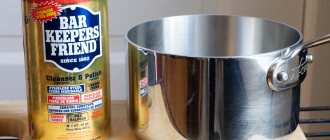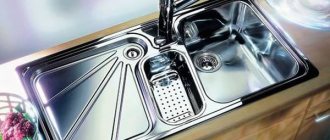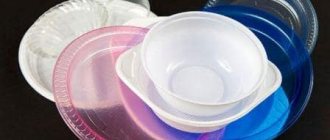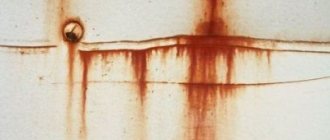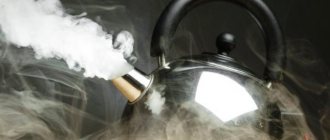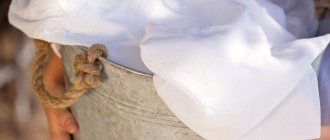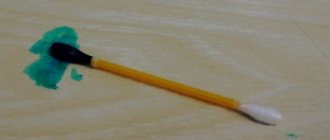Stainless steel cookware is rightfully considered one of the simplest and most convenient to use - no strict rules need to be followed either when cooking or washing. However, often on its bottom and walls one can gradually notice defects: gradually “growing” spots and a “rainbow” appearing. Many consider them a marriage, but is this really so?
Causes of pollution
The material from which the dishes are made includes chromium. It is this that protects stainless steel from the negative effects of the environment. The protective layer that this element creates prevents the formation of corrosive stains and rust on the surface of products. But despite this, the dishes still get dirty.
Why does pollution appear?
- Rust and carbon deposits. If the dishes are not washed, their surface becomes overgrown with grease stains and dirt, as a result of which the stainless steel loses its protective properties and the wear resistance of the material decreases. The metallic luster disappears, the pans become covered with rust and become unusable.
- Rainbow stains. Shapeless purple stains that appear on the bottom of the pan are caused by severe overheating. This happens if you put an empty container on fire. When exposed to high temperatures, the protective film becomes thicker and clearly visible. You can try to remove the stains with sandpaper, but such actions will only make the situation worse. It's best not to touch these spots. They do not affect the quality of prepared dishes.
- Light spots. Small light spots that appear at the bottom of the container are scale (calcium salts). When water boils, salts decompose, particles of which settle as a white coating on microscopic irregularities in the walls of the dish. If the plaque is not removed, it will gradually increase in size, turning into a hard deposit. Which will cause great damage to the product. The same process will occur if you add simple table salt to cold water. Its particles will settle on the surface of the container, and chlorine, which is part of the salt, activates corrosion. In this regard, manufacturers of stainless steel cookware recommend adding table salt after the water in the pan boils. Thus, the particles of the substance will immediately dissolve and have minimal contact with chlorine.
- Dark spots. In addition to calcium salts, tap water also contains silicon salts. When water boils, they settle on the surface and bottom of the pan in the form of small, dark spots. Gradually, these spots become red, and outwardly it seems that the pan is covered with rust. In order not to bring kitchen utensils to this state, you need to get rid of dirt in a timely manner, even if it is small. You can remove small spots with vinegar. If the stains do not disappear after using the product, then the metal is truly rusty.
Read more ► How to clean old coins from rust and oxidation at home: tips from numismatists
Russian stainless steel pots are the best!
The heat distribution layer is made of aluminum alloy, similar to the domestic A5 brand. The method of manufacturing the bottom capsule is diffusion welding (impact bottom).
The thickness of the wall of the container and the lid is 0.8 mm, the thickness of the plate covering the bottom capsule is 0.5 mm. The effective thickness of the aluminum TPC at the center of the bottom is 6.2 mm, at the edge of the bottom - 7.7 mm. The instructions supplied with the product indicate the following information: “The thermo-accumulating compact bottom of our cookware is made of multi-layer light metal with a thickness of 10 mm.”
In fact, the heat distribution bottom is a solid sheet of aluminum (no multi-layering), with an initial thickness of no more than 8.0 mm (before the diffusion welding process). The instructions contain a rather strange text: “The walls of the cookware have a thickness that maintains an operating temperature of 90C.” - it’s funny, they believe in it, these are dishes “that cook after turning off the stove”,
How to wash stainless steel using traditional methods?
The surface of stainless steel kitchen utensils is very vulnerable, although it has such an “iron” name. You need to choose a cleaning product carefully, as some of them can leave scratches on the surface.
It is recommended to remove contamination with non-aggressive substances that can be found in any kitchen.
Lemon juice
Lemon juice will help clean dirty dishes and restore their original shine:
- Pour 1 glass of water into a small container, add 1 tbsp. l. lemon juice. Mix thoroughly.
- The surface of the pan is wiped with a soft sponge dipped in the prepared lemon solution, then washed with water.
- After cleaning, wipe dry.
- To make the pan shine, it is polished with a flannel cloth.
Advice ! Large stains cannot be cleaned with lemon juice. This method is more suitable for minor stains.
If the surface of the pan is very burnt, then you should use activated carbon. Tablets in the amount of 2-3 pieces are crushed into powder and sprinkled over the burnt area. The black powder is lightly moistened with water, turning it into a paste. Rub the resulting mixture onto the problem area and leave for half an hour, then rinse everything off with water.
Vinegar and water
Mix water and vinegar in equal proportions and bring to a boil. The dirty pan is kept for 15 minutes over the steam coming from the boiling vinegar solution. When the dirt softens, it is washed off with a soft sponge. This option is used when you need to clean the outside of the bottom of the pan from carbon deposits.
Soda
You can get rid of burnt old fat using simple soda:
- Pour 5 liters of water into the container and put it on fire.
- After boiling, add 1 pack of soda to the liquid.
- A dirty pan is immersed in a boiling soda solution for 2 hours. If the contamination is small, 1 hour is enough.
- After time, the remaining dirt is wiped off with a soft sponge and soda.
Sprinkle soda over fresh grease stains and burnt marks. After 2 hours, the softened dirt is washed off with a sponge.
Read more ► 7 ways to clean gold and diamonds at home: secrets of jewelers
Ascorbic acid
Using ascorbic acid you can get rid of scale that forms inside the pan. To do this, fill the dirty container with water, then add ascorbic acid, after crushing it to a powder state.
The solution is thoroughly stirred and brought to a boil, then removed from the heat. After complete cooling, the liquid is drained, the remaining scale is wiped off with a damp cloth, and the container is thoroughly rinsed to remove acid.
Glue and laundry soap
To prepare the mixture you will need PVA glue – 1 tablespoon and laundry soap 1/3 of a piece. For better dissolution, rub the soap on a coarse grater.
All ingredients are dissolved in 4 liters of water. Dirty dishes need to be boiled for 30 minutes in the prepared mixture. This method is suitable for removing old dirt.
Is it possible to use pans with rainbow stains?
The product is processed, washed and dried.
Both the first and second methods are equally effective.
ON A NOTE. Instead of citric acid, you can wipe the surface of the dishes with a slice of lemon. How to properly care for stainless steel pots To ensure that your kitchen utensils last as long as possible, follow the following recommendations.
- If possible, use distilled water when preparing.
- The cooking temperature must be stable.
- Before first use, wash the product with soapy water and wipe dry with a towel.
- Salt should only be added to boiling water and stirred thoroughly until completely dissolved.
- Do not leave empty cookware on the fire.
Top 5 Purchased Stainless Steel Cookware Products
You can clean dirty dishes using specialized products, the range of which is quite diverse. Some of them contain chlorine or other harsh ingredients, so you need to be careful when choosing them.
Top 5 most popular stainless steel cleaning products:
- Grease remover "Shumanit". The substance contains alkali, which is the main active ingredient. This unique product is able to cope with any stains, even those that other detergents cannot cope with. Sold in the form of powder, gel or spray, used for cleaning any surfaces. It is enough to apply the solution to the surface and leave for an hour. After the time has passed, the dishes are washed thoroughly.
- Dr. Beckmann. The foam has a high dissolving ability and does not contain abrasive particles. The corrosion inhibitors included in the composition actively protect the metal. The cleaning agent polishes the surface well, returning the product to its original mirror shine.
- Topperr "Stainless Steel". Acts instantly and effectively, eliminates various types of dirt, unpleasant odors, and adds shine. After using this product, the service life of pots and other kitchen utensils made of stainless steel increases.
- Sanitol "Shine of steel". Available in the form of a thick cream with a gentle abrasive base. Easily copes with lime deposits, polishes products, giving them shine. The product is applied to the dirt, rubbed thoroughly, and then washed.
- Vitesse. It has a mild effect, does not contain caustic substances, which is completely safe for the environment. A small amount of the substance is applied to the dirty stain, then rubbed with a damp cloth. When the surface shines, it is washed with water and wiped dry. The product is used no more than once every 3 months.
Work on cleaning dishes is carried out strictly with gloves, otherwise the cleaning chemicals can damage the skin of your hands. Since most of the purchased products have a pungent odor, the room in which the work is carried out must be well ventilated.
Read more ► How to sharpen scissors correctly: 5 methods, procedure and sharpening angle
What not to use
Stainless steel kitchen utensils will lose their shine if they are not cleaned correctly and the wrong products are used.
What not to do:
- Use abrasive substances. Dishes will deteriorate if they are constantly cleaned with products that contain large abrasive particles. It may not be dissolved salt, sand or powder. Washing with such products may leave scratches and abrasions on the shiny surface.
- Clean dishes with hard sponges. The surface of the product will be covered with scratches if the carbon deposits are scrubbed off with a hard sponge or metal scraper. Therefore they should not be used for cleaning.
- Polishing in the wrong direction. Each pan has factory polish lines. If you sand the product without following the directions of the lines, the shiny surface will become covered with deep scratches.
- Use products containing chlorine. Chlorine is the worst enemy of stainless steel. Under its influence, the material oxidizes, and rough scratches form on the walls of the products.
How to clean stains from the bottom of a pan?
The easiest way to get rid of whitish calcium deposits is that in small quantities it can be easily removed with a hard sponge, but you will have to fight with silicon salts. You can remove them in two ways:
- Scrub the bottom of the pan with a metal sponge, brush or fine sandpaper. In this way, stains are removed extremely effectively, but the consequences of such cleaning can be very unpleasant: when friction occurs, new deep scratches appear on the bottom, which only contribute to the deposition of salts. In addition, when using brushes and sandpaper, the bottom gradually becomes thinner and may eventually become leaky.
- Salts react with acids, so for gentle cleaning you can use various acid-containing liquids, for example, vinegar or citric acid diluted in water.
Adding shine
You can restore the original appearance of stainless steel kitchen products and extend their service life by polishing.
The procedure is carried out as follows:
- A soft sponge is soaked in vinegar or a special product designed for polishing steel, then the dishes are wiped with it. You can also use lemon juice. Before use, the juice is diluted in the following proportions: 1 tablespoon of juice per 1 glass of water.
- The polished dishes are washed with clean water and wiped with a dry towel.
- If you wipe a pan with raw potatoes, its surface will become glossy.
